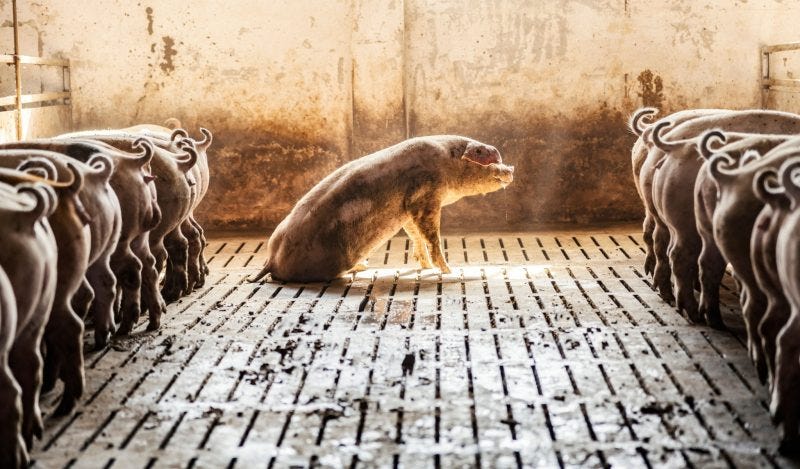Are There Vaccines in our Food Supply?
In my previous articles, we looked at the global war on farmers, the organizations pushing for the Great Food Reset
In my previous articles, we looked at the global war on farmers, the organizations pushing for the Great Food Reset, the tactics used to foist these changes on the public, and the projects underway to remove your access to healthy, farm-fresh foods. Today we will delve into the contentious issue of vaccines in the food supply.
Accurate information on this topic is not easy to find. The USDA and drug developers aren’t required to release any information on veterinary drugs in the development pipeline, so independent detectives are left searching through peer-reviewed papers, university publications, USDA contracts, grant notifications, company white papers, and university websites to learn what is on the horizon. This system is far from transparent, and frankly, I don’t think that’s an accident.
Before any vaccine technology is used on humans, it is usually tried in the veterinary market first due to the incredibly lax regulations. Knowing this, it should come as no surprise that our food animals had been receiving mRNA injections for years before the Covid vaccine rollout.
Around 2014, the USDA granted a conditional license for an mRNA vaccine for use in pigs for Porcine Epidemic Diarrhea Virus. This is equivalent to emergency use authorization and gets around the USDA’s vaccine licensing and authorization process.
In 2015, Merck bought Harrisvaccines to acquire their RNA platform. Merck’s 2015 press release stated that this “RNA Particle technology…represents a breakthrough in vaccine development. It also has a highly versatile production platform able to target a wide range of viruses and bacteria. Pathogens are collected from a farm, and specific genes are sequenced and inserted into RNA particles, making safe, potent vaccines able to provide herd-specific protection.”
Introduced in 2018, Sequivity is Merck’s RNA vaccine platform built on the Harrisvaccines technology. These RNA injections are already in use in pigs. They are customized for different viruses, and each customized injection undergoes no new safety testing; new formulations are deployed immediately. Pork you are eating from the supermarket is already likely treated with these gene therapies.
In 2016, BioNtech and Bayer partnered to develop veterinary mRNA vaccines using Bayer’s veterinary knowledge and the BioNtech MRNA platform (the one used for the Pfizer Covid shot). Given the intervening years for development, there may be a host of new mRNA livestock shots released in the near future.
In October 2021, Iowa State University began a project testing a novel mRNA vaccine against RSV infections in cows, in the form of a subcutaneous implant that continuously releases mRNA into the cow. The anticipated completion date for the study is 2026.
If you think mRNA vaccines are the only problem, think again: according to a 2021 paper published in Frontiers in Veterinary Science, DNA, RNA, and recombinant viral-vector vaccines are all in development. They are touted as capable of quick deployment: no time for pesky safety testing, let alone time to see if humans who consume meat from these animals suffer any long-term health effects. The paper also points out that farmed salmon are already receiving multiple DNA injections for various diseases.
According to Merck’s Veterinary Manual, experimental DNA vaccines have been produced against avian influenza, rabies, bovine viral diarrhea virus, porcine herpesvirus, bovine herpesvirus-1, foot-and-mouth disease, and other veterinary viruses.
All this begs the question: can DNA vaccines change the genetic code of an animal or human? According to a 2017 Moderna white paper titled mRNA Vaccines: Disruptive Innovation in Vaccination, “The key challenge associated with DNA vaccines is that they must penetrate the cell nucleus…Once inside the nucleus, DNA vaccines have a risk of permanently changing a person’s DNA.”
Can genetic injections given to animals affect the person who consumes the animal product? Chinese scientists have published a study wherein mRNA-laced milk was injected into the intestines of mice. The mRNA was successfully absorbed through the digestive tract and became active in their bodies. The researchers plan to follow up with a version where the mice are fed the mRNA rather than being injected, and in their paper’s conclusion, they opine that “In the near future, an mRNA delivery system based on milk-derived exosomes will serve as a platform for mRNA therapeutics development.”
We know that human breast milk was contaminated with mRNA lipid nanoparticles after Covid-19 injections. This raises concerns with the Iowa State project developing a continuous release, RNA implant for cows. How are we confident it would not cross into the milk supply?
Beyond the vaccines for animals lies the frontier of vegetables genetically engineered to deliver mRNA into any human who eats them. The National Science Foundation is funding one of several studies using plants such as lettuce and spinach to generate mRNA gene therapies that enter the human body when the plant is eaten. Plant-based immunization experimentation began more than two decades ago: In 2002, a company called Prodigene was fined millions of dollars when their vaccine-producing GMO corn contaminated 500,000 pounds of soybeans.
RNAi pesticides also present a significant risk to human health. These sprays, used on GMO crops, are designed to genetically modify living organisms in an agricultural setting. RNAi sprays can blow freely in the wind, contaminating vast swaths of fertile farmland and otherwise clean crops, potentially causing genetic modifications to many species beyond their intended target, and even altering organic vegetables grown downwind. In 2017, the EPA approved Monsanto and Dow’s RNAi Smartstax PRO corn, which now accounts for up to 17 percent of the corn grown in the United States, so the corn you are eating in tortilla chips and other processed foods may well contain this gene-silencing technology.
Regarding the potential danger of genetic damage to humans and animal species from RNAi sprays, a report by Jonathan R. Latham and Allison K. Wilson of the Bioscience Research Project notes that “Mammalian digestion is a complex process in which food molecules are taken into the body by many routes. It has been demonstrated in mammals that some of these pathways allow limited entry into the bloodstream of macromolecules such as DNA and intact proteins. Thus absorbed, macromolecules may enter internal organs, muscle tissue, and even embryos. At least in some tissues, foreign DNA enters the nuclei of individual cells.” The authors also note that “long duplexed dsRNAs have previously been discarded as medical therapies for the reason that they induce side effects at low doses. Based on our analysis it seems unlikely that a convincing case can be made for their safe inclusion in food.”
In the Livestock Research Innovation Corporation’s 2021 white paper called “The Future of Livestock Vaccines,” the authors enthusiastically opine that: “The current COVID-19 pandemic has taught us many lessons, including the fact that the development, mass production and approval process of vaccines could be shortened from several years (or decades) to 8-9 months. This will have a significant and long-lasting impact on how livestock vaccines are produced and deployed in the future.”
They remind us that “Good health starts with biosecurity” and that “resulting from the pandemic, society is more attuned to the One Health concept and so vaccination of livestock will be seen as part of a larger health picture, one that includes humans and the environment.”
The Most Dangerous Superstition by Larken Rose - exposes the myth for what it is, showing how nearly everyone, as a result of one particular unquestioned assumption, directly contributes to violence and oppression without even realizing it. $14 ( or $60 with "Government" and a Liberator drive)







Something happened to the food supply in 1979. What went into the food starting around that era, and what is going into the food nowadays has gone steadily into us. We have grown larger and larger and larger, kind of like the spreading blob. It’s not only flab/ fat that we’ve gained, it’s medical issues we are experiencing and slower foggy brains. It’s super obvious that this has been happening for years. Unfortunately, nobody has ever said anything. I’ve always been on my high horse telling everybody I could that we females had no breasts in high school in the early 1970s. Everybody can see the difference in the girls today from us! So obvious, the appalachians pre 80’s are presently the grand Tetons!
Corey Lynn of Corey's Digs, wrote an article for Solari (Catherine Austin Fitts' company) a while back about the food supply and vaccines being somehow implemented into veggies such as tomatoes, lettuce and spinach I believe. There is a lot of evil $$$ behind this.
https://home.solari.com/new-controlled-food-system-is-now-in-place-and-they-will-stop-at-nothing-to-accelerate-their-control/
If animals are being injected, then we can guarantee that we are receiving the byproducts of the "vaccines" as well.